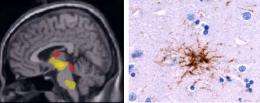Having two neurological diseases at once creates diagnostic confusion

(PhysOrg.com) -- Neurologists at UCSF have studied a group of people who suffer from two neurological disorders at the same time: Alzheimer’s disease and a movement disorder called progressive supranuclear palsy.
Their study assessed the cognitive impairments in this group and characterized their behavioral abnormalities. The clinical features of the two diseases together, the researchers say, are more than a simple combination of the two.
“Our preliminary data suggest that when you have a combination of Alzheimer's disease and progressive supranuclear palsy, that produces a clinical syndrome with overlapping features of both. This can create diagnostic confusion,” said UCSF neurologist Adam Boxer, MD, PhD, the senior author on the study. “Since pathological accumulation of Tau protein is strongly linked to both disorders, but believed to occur by different mechanisms, it may be that if we study this group of people, we will understand more about how tau pathology develops in the brain.”
The work was presented last week by Eric Fine, PhD, a neuropsychology postdoctoral fellow at the UCSF Memory and Aging Center, at the 63rd Annual Meeting of the American Academy of Neurology.
Sum of the Pieces
In their study, Boxer, Fine and their colleagues characterized the clinical features of five people with both Alzheimer's disease and progressive supranuclear palsy at autopsy, compared to 20 people with one or the other.
They found that those with this rare combination of disorders had suffered as if they had just one of the diseases in some ways. Their scores on standard measures of memory loss had been consistent with patients who have Alzheimer's alone, for instance. In other ways, however, the combined condition appeared very different.
Behaviorally, they were worse off, suffering more severe neuropsychiatric abnormalities, particularly delusions. Because of this, Boxer said, people with Alzheimer's and progressive supranuclear palsy together may appear more like patients with frontotemporal dementia, another neurological disorder accompanied by severe changes in behavior. In fact, the combined disease is sometimes misdiagnosed as such.
Progressive supranuclear palsy alone also is often misdiagnosed. A relatively rare disease, caused by the buildup of a protein called Tau in the brain that causes people to have rigid spines, falls and impaired movement of their eyes – signs sometimes mistaken for Parkinson's. People with progressive supranuclear palsy do not respond to drugs used to treat Parkinson's, however.
Currently, no effective treatments exist to treat progressive supranuclear palsy. In an ongoing clinical trial, Boxer is enrolling 300 patients on three continents to test the effect of treating them with Davunetide, a drug by Allon Therapeutics that may block the buildup of toxic forms of Tau in the brain. Allon is providing funds for the trial, but neither Boxer nor his colleagues have a financial stake in the outcome of the trial.
More information: The presentation, titled "The Cognitive and Behavioral Features Associated with Co-Morbid Progressive Supranuclear Palsy and Alzheimer's Disease: More Than the Sum of Its Parts?" was written by Eric M. Fine, Amanda K. LaMarre, Carmela M. Tartaglia, Joel H. Kramer, Bruce L. Miller, William W. Seeley and Adam L. Boxer.













